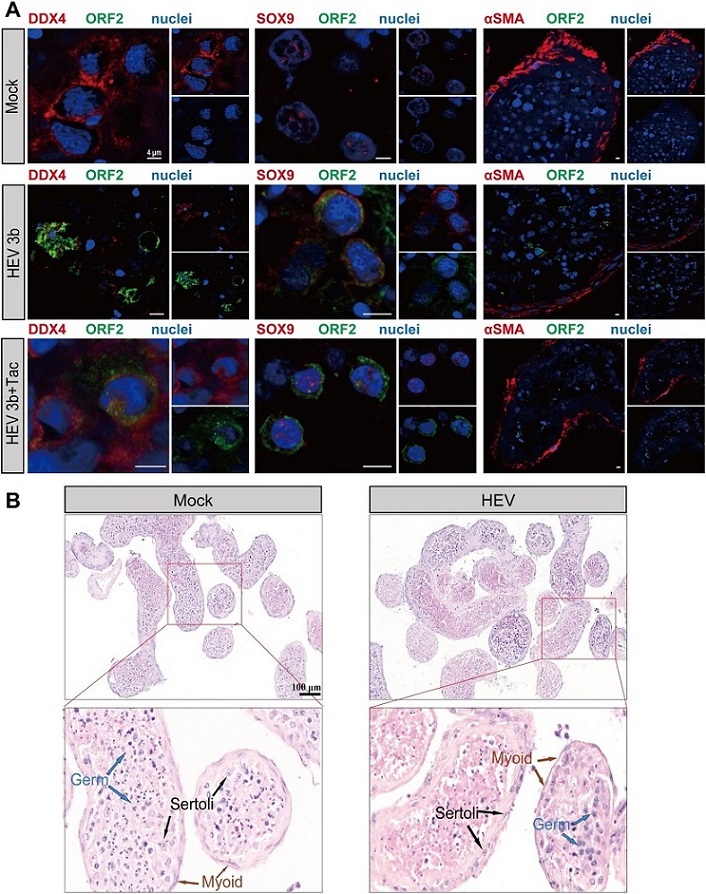BREAKING! Study Finds That Hepatitis E Virus Infects And Replicates In Men’s Testicles And Sertoli Cells
Nikhil Prasad Fact checked by:Thailand Medical News Team May 03, 2024 1 year, 7 months, 2 weeks, 4 days, 1 hour, 17 minutes ago
Medical News: Hepatitis E virus (HEV) infection has become a major concern globally, causing acute viral hepatitis and potentially leading to severe liver complications, especially in vulnerable populations. Recent research has shed light on the ability of HEV to infect and replicate in the male reproductive system, particularly in testicular tissues and Sertoli cells. A new groundbreaking study covered in this
Medical News report that was conducted by scientist from Peking University Health Science Center, Beijing-China, Peking University Third Hospital, Beijing-China and the Third Affiliated Hospital of Zhengzhou University-China, aims to delve into the mechanisms and implications of HEV infection within the male reproductive tract, emphasizing the potential impact on male reproductive health.
 Hepatitis E Virus Infects And Replicates In Men’s Testicles And Sertoli Cells
Characterization and morphology of HEV-infected human testicular cells ex vivo. (A) Immunofluorescence analysis for HEV ORF2 protein and cell markers identified HEV ORF2 protein in DDX4+ germ cells and SOX9+ Sertoli cells, especially in tacrolimus-treated testis tissues infected with HEV genotype 3b (white arrows). No obvious staining was seen in α-SMA+ peritubular cells. Staining for HEV ORF2 was not observed in Mock group testis. Nuclei are stained in blue. Scale bars: 20 μm. (B) Representative field of view of HE stained sections prepared from the testis tissues inoculated with HEV and Mock group.
Understanding Hepatitis E Virus (HEV)
Hepatitis E Virus Infects And Replicates In Men’s Testicles And Sertoli Cells
Characterization and morphology of HEV-infected human testicular cells ex vivo. (A) Immunofluorescence analysis for HEV ORF2 protein and cell markers identified HEV ORF2 protein in DDX4+ germ cells and SOX9+ Sertoli cells, especially in tacrolimus-treated testis tissues infected with HEV genotype 3b (white arrows). No obvious staining was seen in α-SMA+ peritubular cells. Staining for HEV ORF2 was not observed in Mock group testis. Nuclei are stained in blue. Scale bars: 20 μm. (B) Representative field of view of HE stained sections prepared from the testis tissues inoculated with HEV and Mock group.
Understanding Hepatitis E Virus (HEV)
HEV is an RNA virus known to cause hepatitis E, primarily transmitted through the fecal-oral route. It encompasses several genotypes, with HEV genotypes 1 to 4 being the most prevalent and responsible for the majority of human cases. Notably, recent findings have indicated that certain strains of HEV from rats can also infect humans, adding complexity to the viral landscape.
While most HEV infections are acute and self-limiting, a subset of individuals, particularly those with compromised immune systems or underlying liver conditions, can develop chronic HEV infections leading to liver failure. Additionally, HEV has been associated with extrahepatic manifestations, raising questions about its potential impact beyond the liver.
HEV in the Male Reproductive System: Unveiling Tropism and Mechanisms
The presence of HEV in human semen samples has sparked considerable interest, especially concerning its potential impact on male fertility. Initial studies hinted at a high detection rate of HEV in semen samples, particularly in chronic hepatitis E patients under immunosuppressive therapy. However, conflicting results from subsequent studies necessitated a deeper investigation into the tropism and mechanisms of HEV infection in the male reproductive system.
Ex Vivo Model Reveals HEV Tropism for Testicular Tissues and Sertoli Cells
Utilizing
an ex vivo culture of human testis explants and in vitro culture of primary human Sertoli cells, researchers demonstrated that HEV genotypes, specifically HEV3, can infect and replicate within these testicular cells. Interestingly, HEV1 and HEV-C1 showed no signs of replication, highlighting genotype-specific tropism within the male reproductive tract. Furthermore, the introduction of tacrolimus, an immunosuppressant, enhanced HEV replication efficiency in both testis explants and Sertoli cells, mirroring observations in immunocompromised chronic hepatitis E patients.
Impact of HEV Infection on Testicular Tissues and Sertoli Cells
The study uncovered that HEV3 infection induced tissue injury in human testis explants, leading to disruptions in tissue morphology and the loss of germ cells within seminiferous tubules. Moreover, HEV3 infection in primary human Sertoli cells altered the cells' secretome, resulting in increased levels of pro-inflammatory cytokines and chemokines. These findings suggest a potential link between HEV infection and testicular injury, although further investigation is needed to delineate the exact mechanisms and long-term consequences on male reproductive health.
Transcriptomic Analysis: Insights into Chronic HEV Infection in Rabbits
To simulate chronic HEV infection, an immunocompromised rabbit model was utilized. Transcriptomic analysis of testis tissues from chronically infected rabbits revealed downregulation of genes associated with spermatogenesis, highlighting a potential negative impact of HEV on male reproductive function. Interestingly, long-term tacrolimus treatment showed limited influence on the intratesticular transcriptome, emphasizing the complexity of HEV-host interactions and the need for nuanced investigations.
Implications and Future Directions
The findings from this study provide crucial insights into the tropism, mechanisms, and potential impact of HEV infection on male reproductive health. While the study elucidates HEV's ability to infect testicular tissues and Sertoli cells, further research is warranted to explore the broader implications, including the association with male infertility and long-term consequences of chronic HEV infection.
Conclusion
In conclusion, this comprehensive study sheds light on HEV's tropism for the male reproductive system, highlighting genotype-specific infection patterns and the role of immunosuppression in viral replication. The findings underscore the importance of continued research into HEV's impact on male fertility and reproductive health, with implications for clinical management and therapeutic strategies.
The study findings were published in the peer reviewed journal: Emerging Microbes and Infections.
https://www.tandfonline.com/doi/full/10.1080/22221751.2024.2332657
For the latest about Hepatitis E Virus, keep on logging to Thailand
Medical News.
